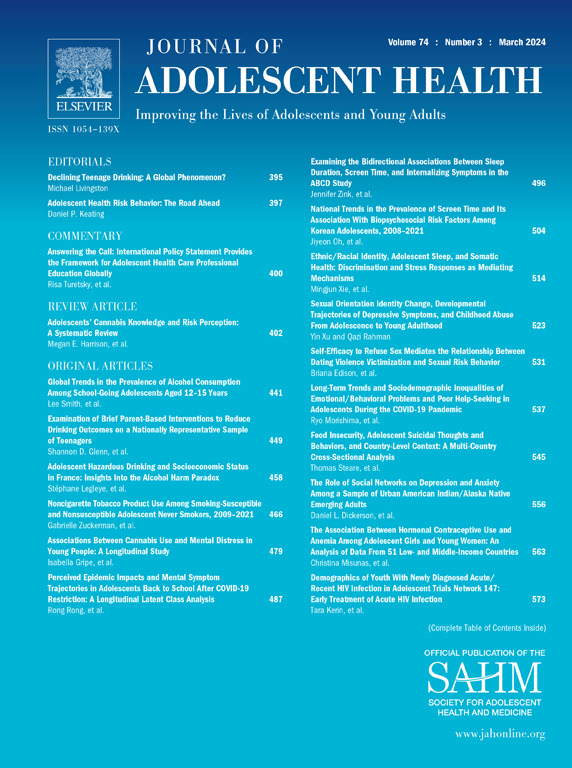青少年性别焦虑症、饮食失调症和心理健康诊断之间的关联。
IF 5.5
2区 医学
Q1 PEDIATRICS
引用次数: 0
摘要
目的:众所周知,变性青少年和患有饮食紊乱症(ED)的青少年的心理健康合并症会增加;然而,人们对性别焦虑症(GD)、饮食紊乱症和心理健康紊乱症之间的关系却知之甚少。本研究的目的是探讨青少年中的 GD、ED 和心理健康诊断之间的关联:从 2009 年至 2022 年间在一家儿科医疗系统就诊的 57,353 名 9-18 岁患者的电子健康记录中提取数据。调整后的逻辑回归模型检验了GD、ED和精神健康诊断之间的关联:与未被诊断为 GD 的青少年相比,被诊断为 GD 的青少年同时被诊断为 ED 的几率明显更高(调整后的几率比 [aOR] = 3.72,95% 置信区间 [CI]:2.98-4.64)。与未被诊断为 GD 的青少年相比,被诊断为 ED 的青少年被诊断为神经性厌食症的几率明显较低(aOR = 0.34,95% CI:0.18-0.61),被诊断为未指定或其他特定 ED 的几率明显较高(aOR = 2.48,95% CI:1.56-3.93)。与既未被诊断为 GD 也未被诊断为 ED 的青少年相比,同时被诊断为 GD 和 ED 的青少年被诊断为焦虑(aOR = 24.01,95% CI:14.85-38.83)、抑郁(aOR = 48.41,95% CI:30.38-77.12)、自杀(aOR = 26.15,95% CI:16.65-41.05)和自残(aOR = 35.79,95% CI:22.48-56.98)的几率明显更高:讨论:与既无 GD 诊断也无 ED 诊断的青少年相比,同时患有 GD 和 ED 诊断的青少年患焦虑症、抑郁症、自杀和自残的风险更大。要了解不同性别青少年的心理健康问题和 ED 之间复杂的相互作用,并为适当的干预措施提供依据,进一步的研究是必不可少的。本文章由计算机程序翻译,如有差异,请以英文原文为准。
Associations Between Gender Dysphoria, Eating Disorders, and Mental Health Diagnoses Among Adolescents
Purpose
Transgender adolescents and adolescents with eating disorders (EDs) are known to have increased mental health comorbidity; however, little is understood about how gender dysphoria (GD), disordered eating and mental health disorders relate to each other. The purpose of this study was to examine associations between GD, ED, and mental health diagnoses among adolescents.
Methods
Data were extracted from the electronic health records of 57,353 patients aged 9-18 seen at a single pediatric health system between 2009 and 2022. Adjusted logistic regression models tested for associations between GD, ED, and mental health diagnoses.
Results
Youth with a GD diagnosis had significantly greater odds of also having an ED diagnosis compared to those without a GD diagnosis (adjusted odds ratio [aOR] = 3.72, 95% confidence interval [CI]: 2.98–4.64). Among those with an ED diagnosis, youth with a GD diagnosis had significantly lower odds of having an anorexia nervosa diagnosis (aOR = 0.34, 95% CI: 0.18–0.61) and significantly greater odds of having an unspecified or other specified ED diagnosis (aOR = 2.48, 95% CI: 1.56–3.93) compared to those without a GD diagnosis. Youth with both GD and ED diagnoses had significantly greater odds of also having a diagnosis of anxiety (aOR = 24.01, 95% CI: 14.85–38.83), depression (aOR = 48.41, 95% CI: 30.38–77.12), suicidality (aOR = 26.15, 95% CI: 16.65–41.05) and self-harm (aOR = 35.79, 95% CI: 22.48–56.98) as compared to those with neither a GD nor an ED diagnosis.
Discussion
Adolescents with co-occurring GD and ED diagnoses are at greater risk for anxiety, depression, suicidality, and self-harm as compared to youth with neither diagnosis. Further research is essential to understand the complex interplay of mental health concerns and EDs among gender diverse adolescents and to inform appropriate interventions.
求助全文
通过发布文献求助,成功后即可免费获取论文全文。
去求助
来源期刊

Journal of Adolescent Health
医学-公共卫生、环境卫生与职业卫生
CiteScore
10.40
自引率
3.90%
发文量
526
审稿时长
46 days
期刊介绍:
The Journal of Adolescent Health is a scientific publication dedicated to enhancing the health and well-being of adolescents and young adults. Our Journal covers a broad range of research topics, spanning from the basic biological and behavioral sciences to public health and policy. We welcome a variety of contributions, including original research papers, concise reports, literature reviews, clinical case reports, opinion pieces, and letters to the editor. We encourage professionals from diverse disciplines such as Anthropology, Education, Ethics, Global Health, Health Services Research, Law, Medicine, Mental and Behavioral Health, Nursing, Nutrition, Psychology, Public Health and Policy, Social Work, Sociology, and Youth Development to share their expertise and contribute to our mission of promoting adolescent health. Moreover, we value the voices of young individuals, family and community members, and healthcare professionals, and encourage them to submit poetry, personal narratives, images, and other creative works that provide unique insights into the experiences of adolescents and young adults. By combining scientific peer-reviewed research with creative expressions, our Journal aims to create a comprehensive understanding of the challenges and opportunities in adolescent and young adult health.
 求助内容:
求助内容: 应助结果提醒方式:
应助结果提醒方式:


